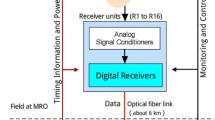Abstract
Backed by advances in digital electronics, signal processing, computation and storage technologies, aperture arrays, which had strongly influenced the design of telescopes in the early years of radio astronomy, have made a comeback. Amid all these developments, an international effort to design and build the world’s largest radio telescope, the Square Kilometre Array (SKA), is ongoing. With its vast collecting area of 1 \(\hbox {km}^2\), the SKA is envisaged to provide unsurpassed sensitivity and leverage technological advances to implement a complex receiver to provide a large field of view through multiple beams on the sky. Many pathfinders and precursor aperture array telescopes for the SKA, operating in the frequency range of 10–300 MHz, have been constructed and operationalized to obtain valuable feedback on scientific, instrumental and functional aspects. This review article looks explicitly into the progression of digital-receiver architecture from the Murchison Widefield Array (precursor) to the SKA1-Low. It highlights the technological advances in analog-to-digital converters (ADCs), field-programmable gate arrays (FPGAs) and central processing unit–graphics processing unit (CPU–GPU) hybrid platforms around which complex digital signal processing systems implement efficient channelizers, beamformers and correlators. The article concludes with a preview of the design of a new generation signal processing platform based on radio frequency system-on-chip (RFSoC).




Similar content being viewed by others
References
Aafreen R., Abhishek R., Ajithkumar B., et al. 2022, arXiv:2207.07054, 21
Bellanger M., Daguet J. 1974, IEEE Trans.Commun., 22, 7
Buch K. D., Bhatporia S., Gupta Y., et al. 2016, J. Astron. Instrum., 5, 14
Caputa K., Harrison S., Ljusic Z., Pleasance M., Zhao E. 2022, in Ground-based and Airborne Telescopes IX, Vol. 12182, Proceedings of SPIE, p. 19
Comoretto G., Chiello R., Roberts M., et al. 2017, J. Astron. Instrum., 6, 17
Comoretto G., Monari J., Belli C., et al. 2020, in Ground-based and Airborne Telescopes VIII, Vol. 11445, Proceedings of SPIE, p. 14
De K., Gupta Y. 2016, Exp. Astron., 41, 25
de Lera Acedo E., Razavi-Ghods N., Troop N., Drought N., Faulkner A. 2015, Exp. Astron., 39, 28
DeBoer D. R., Parsons A. R., Aguirre J. E., et al. 2017, Publ. Astron. Soc. Pac., 129, 27
Deller A. T., Tingay S., Bailes M., West C. 2007, Publ. Astron. Soc. Pac., 119, 19
Dewdney P. E., Hall P. J., Schilizzi R. T., Lazio T. J. L. 2009, Proc. IEEE, 97, 15
Garrett M. A. 2013, in 2013 Africon Conference, IEEE Xplore, p. 5
Girish B. S., Srivani K. S., Subrahmanyan R., et al. 2020, J. Astron. Instrum., 9, 17
Gupta Y. 2014, Metrewavelength Sky, 13, 7
Gupta Y., Ajithkumar B., Kale H., et al. 2017, Curr. Sci., 113, 8
Harris F. J., Dick C., Rice M. 2003, IEEE Trans. Microw. Theory Tech., 51, 18
Lonsdale C. J., Cappallo R. J., Morales M. F., et al. 2009, Proc. IEEE, 97, 9
Manley J., Kapp F. 2012, in 2012 International Conference on Electromagnetics in Advanced Applications, IEEE, p. 4
Morrison I., Bunton J., van Straten W., Deller A., Jameson A. 2020, J. Astron. Instrum., 9, 17
Naldi G., Mattana A., Pastore S., et al. 2017, J. Astron. Instrum., 6, 17
Parsons A. R., Backer D. C., Foster G. S., et al. 2010, Astron. J., 139, 13
Patra N. N., Kanekar N., Chengalur J. N., et al. 2019, Month. Not. R. Astron. Soc., 483, 16
Perley R., Napier P., Jackson J., et al. 2009, Proc. IEEE, 97, 15
Prabu T., Srivani K., Kamini P., et al. 2014, in Astronomical Society of India Conference Series, Vol. 13, p. 5
Prabu T., Srivani K., Roshi D. A., et al. 2015, Exp. Astron., 39, 21
Reddy S. H., Kudale S., Gokhale U., et al. 2017, J. Astron. Instrum., 6, 16
Roy J., Gupta Y., Pen U.-L., et al. 2010, Exp. Astron., 28, 36
Schilizzi R. T., Dewdney P. E., Lazio T. J. W. 2008, in Ground-based and Airborne Telescopes II, Vol. 7012, Proceedings of SPIE, p. 13
Schillirò F., Alderighi M., Belli C., et al. 2020, in Ground-based and Airborne Telescopes VIII, Vol. 11445, Proceedings of SPIE, p. 16
Schinckel A. E., Bunton J. D., Cornwell T. J., Feain I., Hay S. G. 2012, in Ground-based and Airborne Telescopes IV, Vol. 8444, Proceedings of SPIE, p. 12
Tingay S. J., Goeke R., Bowman J. D., et al. 2013, Publ. Astron. Soc. Aust., 30, 21
van Haarlem M. P., Wise M. W., Gunst A., et al. 2013, Astron. Astrophys., 556, 53
Wayth R. B., Tingay S. J., Trott C. M., et al. 2018, Publ. Astron. Soc. Aust., 35, 9
Acknowledgements
We thank Raman Research Institute (RRI) for supporting the Integrated Prototype Board activities taking place under the SKA India Consortium (SKAIC) project proposal (DPR 2019). Authors Girish, Srivani and Prabu thank Manjunath Bevinamar, Hardik Purohit and Jeetesh Tiwari at Avnet India Pvt. Ltd., for providing valuable insights into Gen 3 RFSoCs andenthusiastically supporting us during IPB activities. Thanks to Shirisha at RRI for proofreading.
Author information
Authors and Affiliations
Corresponding author
Additional information
This article is part of the Special Issue on “Indian Participation in the SKA”.
Rights and permissions
About this article
Cite this article
Girish, B.S., Reddy, S.H., Sethi, S. et al. Progression of digital-receiver architecture: From MWA to SKA1-Low, and beyond. J Astrophys Astron 44, 28 (2023). https://doi.org/10.1007/s12036-023-09921-3
Received:
Accepted:
Published:
DOI: https://doi.org/10.1007/s12036-023-09921-3




